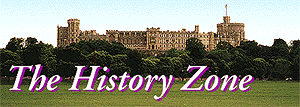 |
 |
 We are grateful to the Windsor Local History Publications Group for permission to include this article which first appeared in Windlesora No. 1 in 1981. For a full list of articles published in Windlesora since 1982, please click here.
|
A Peep Behind The Ivy The Old Burial Ground at Madeira Walk, Bachelor's Acre Being generally a curious person, I had often wondered, as I passed it, what sort of people were buried in the Acre Grave Yard which is located alongside Madeira Walk. What was under all that ivy that covered up so much of "yesterday's" people of Windsor? It had been a wilderness for very many years, so one day, assisted by my husband, I began to tear away the ivy, and there stood these old stones. Some were remarkably clear and could be read at once, but some were quite blank, and there were those that needed careful study to make out the letters.
I got a book out of the library, and in all seriousness the author suggested that using a torch after dark was a very good way of reading old stones. He did it and sent two girls, walking through the churchyard, screaming home! I prefer the daylight.
Then I was advised to try the flour method. Ordinary flour was sprinkled on the stone, lightly brushed off, and it was hoped that the flour would stick in the writing and make reading it easier. This was partly successful, but many of the stones stood upright, which made aiming the flour difficult. I found it easier to trace the letters with my fingers, and so to get the feel of the letter, and, with a bit of guesswork I could often make out what I could not actually read. I also have a small nail brush which I used to brush the letters and I often washed the stones. One of the main troubles was that the ivy had cut into them making lines that should not be there.
I was greatly helped by the list made by the Borough of New Windsor, "Improvement of Old Burial Ground 1938. Inscriptions on Existing Gravestones". This list is now in the Windsor Public Library (Reference Section).
Two stones which were not on the 1938 list, and must have been counted as unreadable, we read. The first was very clear, but the stone was of a darker material than the other gravestones. The inscription we read was to Mary Elizabeth Winnington Ingram, who died aged 3 years and 7 months on 18th June 1854. Had she lived, she would have been a cousin to Bishop Winnington Ingram, Bishop of London. The other was broken showing only the Christian name Charles. However, my husband found two more pieces of this stone hidden behind, and this gave us the first letter of the surname - L. With the use of Raymond South's book entitled "The Fifth Hall Book of the Borough of New Windsor 1828 - 1882" (page 197), we feel pretty sure whose gravestone we had found - Charles Layton, Mayor of Windsor 1816 - 17. His family owned a restaurant on the corner of Thames Street and Station Approach which only closed within living memory.
Buried here are Charles Knight, and his father, also Charles Knight, who started the Windsor Express newspaper.The Charles Knight Gateway, The Old Burial Ground,
Madeira Walk, Bachelors Acre
Here also is Sergeant Frederick McNamee, of the 97th Regiment of Foot, who, according to his death certificate, died in 1854 of Phthisis Pulmonalis, which, I think is T.B. on the lungs. His stone was "erected by his comrade sergeants as a mark of their regard and esteem". This regiment then went to the Crimean War.
I used a small notebook to copy out the inscriptions as loose papers tended to get mixed up and were misleading. But I was lucky as many of the gravestones were clear and the old council list was very helpful.
Recently, I have been able to see a photostat of the original title deed - and it is noted that John Hatch Esq., and the Rev. the Vicar and Church Wardens of New Windsor agreed "in the 50th year of the reign of our sovereign Lord George III by the Grace of God etc. etc. ..." But it appears that John Hatch sold part of his garden for the graveyard. The Vicar was the Rev. Henry Plumley, and the Churchwardens were Messrs Daniel Smith, Joseph Sharman and William Cooper. The garden was behind John Hatch's house and cost 300 guineas (£315). The piece of land sold was to be fenced off from the rest of the garden by a substantial brick wall of the same height as the adjoining wall of Mr. Sarneys's, and it was agreed that this wall was to be built to shut off any communication or road from or to the garden. This wall was to be built and maintained by the Parish, 17 February 1810.
I rather wonder how graves dated earlier than 1810 came to be in this ground?Elizabeth Brown
See also The Tank at Bachelor's Acre The History Zone Index Royal Windsor Home Page
To contact us, email Thamesweb.